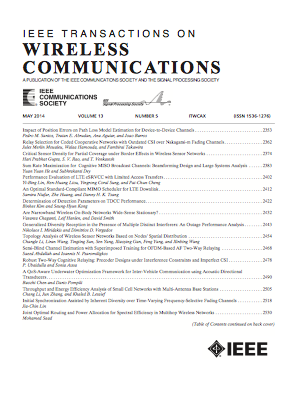Conformal Intelligent Reflecting Surfaces-Assisted Networks With Reflection Constraints
IF 10.7
1区 计算机科学
Q1 ENGINEERING, ELECTRICAL & ELECTRONIC
引用次数: 0
Abstract
The integration of intelligent reflecting surfaces (IRS) onto structures takes advantage of its electrically thin and flexible properties, effectively transforming original obstructions into potential serving nodes. However, existing works model IRS as a planar array, which is not well coupled with the infrastructural shape, posing challenges to future large-scale deployment. Therefore, this paper introduces conformal IRS and proposes a reflection constraint model owing to the curvature imparted by the conformal deployment of IRS, based on which the conformal IRS-assisted network is modeled and system-level performance analysis is derived via stochastic geometry. Specifically, considering infrastructure facades’ non-planar feature, to balance the accuracy and analytical tractability, randomly located infrastructures are modeled as cylinders based on the Boolean scheme, and conformal IRSs are deployed around a fraction具有反射约束的共形智能反射面辅助网络
将智能反射面(IRS)集成到结构上,利用其电薄和柔性的特性,有效地将原始障碍物转化为潜在的服务节点。然而,现有的工作将IRS建模为平面阵列,这与基础设施的形状没有很好地耦合,给未来的大规模部署带来了挑战。因此,本文引入了保形IRS,并提出了保形IRS部署带来的曲率反射约束模型,在此基础上建立了保形IRS辅助网络模型,并通过随机几何推导了系统级性能分析。具体而言,考虑到基础设施立面的非平面特征,为了平衡准确性和分析可追踪性,基于布尔格式将随机定位的基础设施建模为圆柱体,并在其一小部分周围部署保形IRSs。此外,保形IRS的表面曲率调节了系统内视距路径的分布及其有效照度。分别得到了IRS完美反射和随机散射两种不同状态下的成功反射概率和有效反射元,并进一步导出了覆盖概率。数值结果表明,与二维平面IRS相比,保形IRS虽然会略微降低覆盖范围,但会显著提高网络连通性。
本文章由计算机程序翻译,如有差异,请以英文原文为准。
求助全文
约1分钟内获得全文
求助全文
来源期刊
CiteScore
18.60
自引率
10.60%
发文量
708
审稿时长
5.6 months
期刊介绍:
The IEEE Transactions on Wireless Communications is a prestigious publication that showcases cutting-edge advancements in wireless communications. It welcomes both theoretical and practical contributions in various areas. The scope of the Transactions encompasses a wide range of topics, including modulation and coding, detection and estimation, propagation and channel characterization, and diversity techniques. The journal also emphasizes the physical and link layer communication aspects of network architectures and protocols.
The journal is open to papers on specific topics or non-traditional topics related to specific application areas. This includes simulation tools and methodologies, orthogonal frequency division multiplexing, MIMO systems, and wireless over optical technologies.
Overall, the IEEE Transactions on Wireless Communications serves as a platform for high-quality manuscripts that push the boundaries of wireless communications and contribute to advancements in the field.

 求助内容:
求助内容: 应助结果提醒方式:
应助结果提醒方式:


